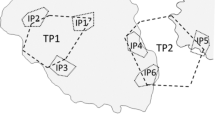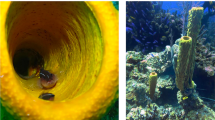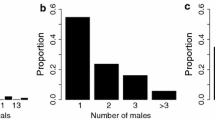Synopsis
We present a detailed description of the social and mating system of the protogynous reef herbivoreSparisoma viride at the fringing reef of Bonaire (Netherlands Antilles). Initial phase (IP) fish and terminal phase (TP) males occur either in one- or in multi-male groups, which are compared quantitatively with respect to the use of space, size composition, social interactions and sexual activity. One-male groups consist of one TP male plus 1–14 IP females, whereas in multi-male groups up to 14 TP males and about twice as many IP fish share a common home range. The two social units further show marked differences in vertical distribution (one-male groups are restricted to depths between 3 and 22 m, multi-male groups mainly residing < 3 m), size composition (a larger proportion of small adults live in multi-male groups), size and stability of the range (larger in one-male groups) and sexual activity (daily spawning of one-male group members inside their normal home range; no activity in multi-male groups on the shallow reef). Sexual activity occurred daily, throughout the year, with no evidence for tidal tracking or major seasonal or lunar patterns. The one-male groups constitute less than 20% of the adult stock but control up to 77% of the inhabited reef. As a result they have access to higher-yield food patches and to suitable spawning sites inside their home range. Although members of both units appear to defend their common home range against intruding conspecifics, the degree of territoriality is clearly higher in one-male groups. We discuss the relative importance of food, shelter, mates and mating sites as defended resources and some life history implications. The complex social and mating system ofS. viride shows much resemblance to that of another Caribbean scarid,Scarus iserti. This complexity seems to reflect the capacity of individuals to flexibly adapt their feeding, mating and life history styles to an unpredictable environment. We propose thatS. viride is a good study animal to test adaptive explanations for its territorial organization and complex life history patterns.
Similar content being viewed by others
References cited
Bruggemann, J.H., M.J.H. van Oppen & A.M. Breeman. 1994a. Foraging by the stoplight parrotfishSparisoma viride. I. Food selection in different, socially determined habitats. Mar. Ecol. Prog. Ser. 106: 41–55.
Bruggemann, J.H., J. Begeman, E.M. Bosma, P. Verburg & A.M. Breeman. 1994b. Foraging by the stoplight parrotfishSparisoma viride. II. Intake and assimilation of food, protein, and energy. Mar. Ecol. Prog. Ser. 106: 57–71.
Bruggemann, J.H., J.M. van Rooij, J.J. Videler & A.M. Breeman, 1995. Dynamics and limitations of herbivore populations on a Caribbean coral reef. pp. 153–190. In: J.H. Bruggemann, Parrotfish Grazing On Coral Reefs: A Trophic Novelty, Ph.D. Thesis, University of Groningen, Groningen.
Buckman, N.S. & N.C. Ogden. 1973. Territorial behavior of the striped parrotfishScarus croicensis Bloch (Scaridae). Ecology 54: 1377–1382.
Cardwell, J.K. 1989. Behavioural endocrinology of the stoplight parrotfish, Sparisoma viride, a protogynous coral reef fish, Ph.D. Thesis, University of British Columbia, Vancouver. 127 pp.
Clifton, K.E. 1989. Territory sharing by the Caribbean striped parrotfish,Scarus iserti: patterns of resource abundance, group size and behaviour. Anim. Behav. 37: 90–103.
Clifton, K.E. 1990. The costs and benefits of territory sharing for the Caribbean coral reef fish,Scarus iserti. Behav. Ecol. Sociobiol. 26: 139–147.
Clifton, K.E. 1991. Subordinate group members act as food-finders within striped parrotfish territories. J. exp. mar. Biol. Ecol. 145: 141–148.
Choat, J.H. & D.R. Robertson. 1975. Protogynous hermaphroditism in fishes of the family Scaridae. pp. 263–283. In: R. Reinboth (ed.) Intersexuality in the Animal Kingdom. Springer Verlag, Heidelberg.
Colin, P.L. & L.J. Bell. 1991. Aspects of the spawning of labrid and scarid fishes (Pisces: Labroidei) at Enewetak Atoll, Marshall Islands with notes on other families. Env. Biol. Fish. 31: 229–260.
Colin, P.L. & I. Clavijo. 1988. Spawning activity of fishes producing pelagic eggs on a shelf edge coral reef, Southwestern Puerto Rico. Bull. mar. Sci. 43: 249–279.
Davies, N.B. & A.I. Houston. 1984. Territory economics. pp. 148–169. In: J.R. Krebs & N.B. Davies (ed.) Behavioural Ecology, An Evolutionary Approach, Blackwell Scientific Publications, Oxford.
Emlen, S.T. & L.W. Oring. 1977. Ecology, sexual selection, and the evolution of mating systems. Science 197: 215–223.
Ghiselin, M.T. 1969. The evolution of hermaphroditism among animals. Quart. Rev. Biol. 44: 189–208.
Iwasa, Y. 1991. Sex change evolution and cost of reproduction. Behav. Ecol. 2: 56–68.
Kaufmann, J.H. 1983. On the definitions and functions of dominance and territoriality. Biol. Rev. 58: 1–20.
Koltes, K.H. 1993. Aspects of the reproductive biology and social structure of the stoplight parrotfishSparisoma viride, at Grand Turk, Turks and Caicos islands, B.W.I. Bull. mar. Sci. 522: 792–805.
Ogden, J.C. & N.S. Buckman. 1973. Movements, foraging groups, and diurnal migrations of the striped parrotfishScarus croicensis Bloch (Scaridae). Ecology 543: 589–596.
Randall, J.E. & H.A. Randall. 1963. The spawning and early development of the Atlantic parrotfish,Sparisoma rubripinne, with notes on other scarid and labrid fishes. Zoologica (New York) 48: 49–60.
Reinboth, R. 1968. Protogynie bei Papageifischen (Scaridae). Z. Naturf. 23: 852–855.
Robertson, D.R. & R.R. Warner. 1978. Sexual patterns in the labroid fishes of the Western Caribbean, II: The parrotfishes (Scaridae). Smiths. Contr. Zool. 255: 1–26.
Robertson, D.R., C.W. Petersen & J.D. Brawn. 1990. Lunar reproductive cycles of benthic-brooding reef fishes: reflections of larval biology or adult biology? Ecol. Monogr. 60: 311–329.
Robertson, D.R., H.P.A. Sweatman, E.A. Fletcher & M.G. Cleland. 1976. Schooling as a mechanism for circumventing the territoriality of competitors. Ecology 57: 1208–1220.
Shapiro, D.Y. 1991. Intraspecific variability in social systems of coral reef fishes. pp. 331–355. In: P.F. Sale (ed.) The Ecology of fishes on Coral Reefs, Academic Press, San Diego.
Shapiro, D.Y., D.A. Hensley & R.S. Appeldoorn. 1988. Pelagic spawning and egg transport in coral-reef fishes: a skeptical overview. Env. Biol. Fish. 221: 3–14.
Sokal, R.R. & F.J. Rohlf. 1981. Biometry. W.H. Freeman, New York. 859 pp.
Thresher, R.E. 1984. Reproduction in reef fishes. TFH Publications, Neptune City. 399 pp.
van Rooij, J.M. & J.J. Videler. 1996. A simple field method for stereo-photographic length measurement of free-swimming fish: merits and constraints. J. Exp. Mar. Biol. Ecol. (in press).
van Rooij, J.M., J.H. Bruggemann, J.J. Videler & A.M. Breeman. 1995a. Plastic growth of the herbivorous reef fishSparisoma viride: field evidence for a trade-off between growth and reproduction. Mar. Ecol. Prog. Ser. 122: 93–105.
van Rooij, J.M., J.H. Bruggemann, J.J. Videler & A.M. Breeman. 1995b. Ontogenetic, social, spatial and seasonal variations in condition of the reef herbivoreSparisoma viride. Mar. Biol. 123: 269–275.
van Rooij, J.M., E. de Jong, F. Vaandrager & J.J. Videler. 1996a. Resource and habitat sharing by the stoplight parrotfish,Sparisoma viride, a Caribbean reef herbivore. Env. Biol. Fish. 47: 81–91.
van Rooij, J.M., J.P. Kok & J.J. Videler. 1996b. Local variability in population structure and density of the protogynous reef herbivoreSparisoma viride. Env. Biol. Fish. 47: 65–80.
Warner, R.R. 1980. The coevolution of behavioral and life-history characteristics. pp. 151–188. In: G.W. Barlow & J.S. Silverberg (ed.) Sociobiology: Beyond Nature-Nurture? Westview Press, Boulder.
Warner, R.R. 1988. Sex change in fishes: hypotheses, evidence, and objections. Env. Biol. Fish. 22: 81–90.
Warner, R.R. 1991. The use of phenotypic plasticity in coral reef fishes as tests of theory in evolutionary ecology. pp. 387–398. In: P.F. Sale (ed.) The Ecology of Fishes on Coral Reefs, Academic Press, San Diego.
Warner, R.R. & I.F. Downs. 1977. Comparative life histories: growth vs. reproduction in normal males and sex-changing hermaphrodites of the striped parrotfish,Scarus croicensis. Proc. 3rd Int. Cor. Reef Symp. 1: 275–281.
Warner, R.R. & D.R. Robertson 1978. Sexual patterns in the labroid fishes of the Western Caribbean, I: The wrasses (Labridae). Smiths. Contr. Zool. 254: 1–27.
Warner, R.R., D.R. Robertson & E.G. Leigh. 1975. Sex change and sexual selection. Science 190: 633–638.
Wootton, R.J. 1990. Ecology of teleost fishes. Chapman & Hall, London. 404 pp.
Author information
Authors and Affiliations
Rights and permissions
About this article
Cite this article
van Rooij, J.M., Kroon, F.J. & Videler, J.J. The social and mating system of the herbivorous reef fishSparisoma viride: one-male versus multi-male groups. Environ Biol Fish 47, 353–378 (1996). https://doi.org/10.1007/BF00005050
Received:
Accepted:
Issue Date:
DOI: https://doi.org/10.1007/BF00005050




